You are currently browsing the category archive for the ‘Hindustani music’ category.
 ದಕ್ಷಿಣ ಭಾರತದ ಶಾಸ್ತ್ರೀಯ ಸಂಗೀತವು ಕರ್ನಾಟಕ ಸಂಗೀತವೆಂಬ ಹೆಸರಿನಲ್ಲಿ ಪ್ರಖ್ಯಾತವಾಗಿರುವುದು ಸರಿಯಷ್ಟೇ. ಆದರೆ ಈ ಸಂಗೀತ ಪ್ರಕಾರದಲ್ಲಿ ಆಸಕ್ತಿಯುಳ್ಳ ಕೇಳುಗರು ಒಂದಂಶವನ್ನು ತಪ್ಪದೇ ಗಮನಿಸುತ್ತಾರೆ. ಕರ್ನಾಟಕ ಸಂಗೀತವು ಕರ್ನಾಟಕವೊಂದೇ ಅಲ್ಲದೆ, ಬೇರೆ ರಾಜ್ಯಗಳಲ್ಲೂ ರೂಢಿಯಲ್ಲಿದೆ, ಇಲ್ಲಿಗಿಂತ ಹೆಚ್ಚಾಗಿಯೇ! ಸುಪ್ರಸಿದ್ಧರೆನಿಸಿದ ಬಹಳಷ್ಟು ಕರ್ನಾಟಕ ಸಂಗೀತಗಾರರು ತಮಿಳರು ಅಥವ ತೆಲುಗರು. ತ್ಯಾಗರಾಜರೇ ಮೊದಲಾದ ಕರ್ನಾಟಕ ಸಂಗೀತದ ತ್ರಿಮೂರ್ತಿಗಳನ್ನೊಳಗೊಂಡು ಬಹಳಷ್ಟು ಜನ ವಾಗ್ಗೇಯಕಾರರು ಕನ್ನಡಿಗರಲ್ಲ. ಇನ್ನು ಕನ್ನಡದವರೇ ಆದ ಮೈಸೂರು ವಾಸುದೇವಾಚಾರ್ಯರಂಥವರೂ ಕನ್ನಡದಲ್ಲಿ ಬರೆದಿದ್ದು ಇಲ್ಲವೇ ಇಲ್ಲವೆನ್ನುವಷ್ಟು ಕಡಿಮೆ – ಒಂದೋ ಎರಡೋ. ಹೀಗಾಗಿ ಹರಿದಾಸರ ರಚನೆಗಳನ್ನು ಬಿಟ್ಟರೆ, ಇಂದು ಕರ್ನಾಟಕ ಸಂಗೀತದಲ್ಲಿ ಪ್ರಚಲಿತವಾಗಿರುವ ಅತಿ ಹೆಚ್ಚು “ಕೃತಿ” ಎಂಬ ಪ್ರಕಾರದ ರಚನೆಗಳು ತೆಲುಗು, ಸಂಸ್ಕೃತ, ಮತ್ತು ಕೆಲಮಟ್ಟಿಗೆ ತಮಿಳು ಭಾಷೆಯವು. ಹರಿದಾಸರ ಹೆಚ್ಚಿನ ರಚನೆಗಳ ಮೂಲ ಸಂಗೀತರೂಪವೂ ಉಳಿಯದೇ ಹೋಗಿರುವುದರಿಂದ, ನಾವು ಕೇಳುವ ಹರಿದಾಸ ‘ಕೃತಿ’ಗಳಲ್ಲಿ ಹೆಚ್ಚಿನವು ಸಂಗೀತದ ಮಟ್ಟಿಗೆ ಹೇಳುವುದಾದರೆ, ತ್ಯಾಗರಾಜಾದಿಗಳ ನಂತರದವು. ಅಂದಮೇಲೆ ಕರ್ನಾಟಕ ಸಂಗೀತದಲ್ಲಿ ಕರ್ನಾಟಕವೆಲ್ಲಿ? ಕನ್ನಡವೆಲ್ಲಿ? ಎಂಬ ಪ್ರಶ್ನೆಗಳು ಏಳುವುದು ಸಹಜವೇ.
ದಕ್ಷಿಣ ಭಾರತದ ಶಾಸ್ತ್ರೀಯ ಸಂಗೀತವು ಕರ್ನಾಟಕ ಸಂಗೀತವೆಂಬ ಹೆಸರಿನಲ್ಲಿ ಪ್ರಖ್ಯಾತವಾಗಿರುವುದು ಸರಿಯಷ್ಟೇ. ಆದರೆ ಈ ಸಂಗೀತ ಪ್ರಕಾರದಲ್ಲಿ ಆಸಕ್ತಿಯುಳ್ಳ ಕೇಳುಗರು ಒಂದಂಶವನ್ನು ತಪ್ಪದೇ ಗಮನಿಸುತ್ತಾರೆ. ಕರ್ನಾಟಕ ಸಂಗೀತವು ಕರ್ನಾಟಕವೊಂದೇ ಅಲ್ಲದೆ, ಬೇರೆ ರಾಜ್ಯಗಳಲ್ಲೂ ರೂಢಿಯಲ್ಲಿದೆ, ಇಲ್ಲಿಗಿಂತ ಹೆಚ್ಚಾಗಿಯೇ! ಸುಪ್ರಸಿದ್ಧರೆನಿಸಿದ ಬಹಳಷ್ಟು ಕರ್ನಾಟಕ ಸಂಗೀತಗಾರರು ತಮಿಳರು ಅಥವ ತೆಲುಗರು. ತ್ಯಾಗರಾಜರೇ ಮೊದಲಾದ ಕರ್ನಾಟಕ ಸಂಗೀತದ ತ್ರಿಮೂರ್ತಿಗಳನ್ನೊಳಗೊಂಡು ಬಹಳಷ್ಟು ಜನ ವಾಗ್ಗೇಯಕಾರರು ಕನ್ನಡಿಗರಲ್ಲ. ಇನ್ನು ಕನ್ನಡದವರೇ ಆದ ಮೈಸೂರು ವಾಸುದೇವಾಚಾರ್ಯರಂಥವರೂ ಕನ್ನಡದಲ್ಲಿ ಬರೆದಿದ್ದು ಇಲ್ಲವೇ ಇಲ್ಲವೆನ್ನುವಷ್ಟು ಕಡಿಮೆ – ಒಂದೋ ಎರಡೋ. ಹೀಗಾಗಿ ಹರಿದಾಸರ ರಚನೆಗಳನ್ನು ಬಿಟ್ಟರೆ, ಇಂದು ಕರ್ನಾಟಕ ಸಂಗೀತದಲ್ಲಿ ಪ್ರಚಲಿತವಾಗಿರುವ ಅತಿ ಹೆಚ್ಚು “ಕೃತಿ” ಎಂಬ ಪ್ರಕಾರದ ರಚನೆಗಳು ತೆಲುಗು, ಸಂಸ್ಕೃತ, ಮತ್ತು ಕೆಲಮಟ್ಟಿಗೆ ತಮಿಳು ಭಾಷೆಯವು. ಹರಿದಾಸರ ಹೆಚ್ಚಿನ ರಚನೆಗಳ ಮೂಲ ಸಂಗೀತರೂಪವೂ ಉಳಿಯದೇ ಹೋಗಿರುವುದರಿಂದ, ನಾವು ಕೇಳುವ ಹರಿದಾಸ ‘ಕೃತಿ’ಗಳಲ್ಲಿ ಹೆಚ್ಚಿನವು ಸಂಗೀತದ ಮಟ್ಟಿಗೆ ಹೇಳುವುದಾದರೆ, ತ್ಯಾಗರಾಜಾದಿಗಳ ನಂತರದವು. ಅಂದಮೇಲೆ ಕರ್ನಾಟಕ ಸಂಗೀತದಲ್ಲಿ ಕರ್ನಾಟಕವೆಲ್ಲಿ? ಕನ್ನಡವೆಲ್ಲಿ? ಎಂಬ ಪ್ರಶ್ನೆಗಳು ಏಳುವುದು ಸಹಜವೇ.
ಆದರೆ ಮೇಲ್ನೋಟಕ್ಕೆ ಕನ್ನಡ ಹೆಚ್ಚಾಗಿ ಕಾಣದಿದ್ದರೂ, ಸ್ವಲ್ಪ ಒಳಹೊಕ್ಕು ನೋಡಿದಾಗ, ಸಂಗೀತದಲ್ಲಿ ಕನ್ನಡವು ಹಾಸುಹೊಕ್ಕಾಗಿರುವುದು ಕಂಡು ಬರುತ್ತದೆ.
ಅಂದಹಾಗೆ ಕರ್ನಾಟಕ ಸಂಗೀತವೆಂಬ ಹೆಸರು ನಮ್ಮ ಸಂಗೀತಕ್ಕೆ ಬಹಳ ಹಳೆಯ ಹೆಸರಲ್ಲ. ಅದು ಸುಮಾರಾಗಿ ಪ್ರಚಾರಕ್ಕೆ ಬಂದು ಒಂದೂವರೆ ಶತಮಾನವಷ್ಟೇ ಆಗಿರಬಹುದು. ಕರ್ನಾಟಕ ಸಂಗೀತದ ಪಿತಾಮಹರೆಂದು ಪುರಂದರ ದಾಸರ ಹೆಸರು ದಾಖಲಾಗಿರುವುದೂ ೧೯೦೪ ರಲ್ಲಿ ಪ್ರಕಟವಾದ, ಸುಬ್ಬರಾಮ ದೀಕ್ಷಿತರ ಸಂಗೀತ ಸಂಪ್ರದಾಯ ಪ್ರದರ್ಶಿನಿಯಲ್ಲಿ. ಹಾಗೆಂದರೆ ಆ ಪುಸ್ತಕದಲ್ಲಿ ದಾಖಲಾಗುವ ಮೊದಲು ತಮಿಳುನಾಡಿನ ತಂಜಾವೂರು ಪ್ರಾಂತ್ಯದಲ್ಲಿ ಪುರಂದರ ದಾಸರು “ಕರ್ನಾಟಕ” ಸಂಗೀತದ ಬಾಲ ಪಾಠಗಳ ಪದ್ಧತಿಯನ್ನು ಸಿದ್ಧಮಾಡಿದವರು ಎಂಬ ನಂಬಿಕೆ ಹಾಸುಹೊಕ್ಕಾಗಿದ್ದಿರಬೇಕು. ಸುಮಾರಾಗಿ ೧೮ನೇ ಶತಮಾನದ ಮೊದಲ ದಶಕಗಳಲ್ಲಿ ತಂಜಾವೂರಿನ ರಾಜ ತುಳಜಾಜಿ ಬರೆದ ‘ಸಂಗೀತ ಸಾರಾಮೃತ’ವೆಂಬ ಹೊತ್ತಿಗೆಯಲ್ಲಿ ಆತ ಈ ಬಗ್ಗೆ ಪ್ರಸ್ತಾಪಿಸುತ್ತಾನೆ. ಹಾಗಾಗಿ ಕರ್ನಾಟಕ ಸಂಗೀತವೆಂಬ ಹೆಸರು ಮೊದಲು ಬಂದದ್ದು ತಮಿಳು ಮಾತನಾಡುವ ಪ್ರದೇಶದಲ್ಲೇ ಎಂಬುದರಲ್ಲಿ ಅನುಮಾನವಿಲ್ಲ,
ಭಾರತೀಯ ಸಂಗೀತವು ಸುಮಾರು ೧೨-೧೩ನೇ ಶತಮಾನಗಳ ತನಕ ಏಕರೂಪವಾಗಿತ್ತೆಂಬುದು, ನಂತರ ಮಹಮ್ಮದೀಯರ ಆಕ್ರಮಣದೊಡನೆ, ಅವರೊಡನೆ ಬಂದ ಪರ್ಶಿಯನ್ ಹಾಗೂ ಇತರ ಮಧ್ಯಪೂರ್ವ ದೇಶಗಳ ಸಂಗೀತದ ಪ್ರಭಾವದಿಂದ ಎರಡು ಕವಲಾಯಿತೆಂಬುದು ಸುಸ್ಪಷ್ಟ. ಇದನ್ನು ಸಂಗೀತ ಶಾಸ್ತ್ರ ಗ್ರಂಥಗಳ ಹಿನ್ನೆಲೆಯಿಂದ ಗುರುತಿಸಬಹುದು. ದಕ್ಷಿಣದ ಕವಲಿಗೆ ಕರ್ನಾಟಕದ, ಕನ್ನಡಿಗರ ಕೊಡುಗೆ ಮಹತ್ವದ್ದು. ಸಂಗೀತವೆನ್ನುವುದು ನಿಂತ ನೀರಲ್ಲ – ಹರಿವ ನದಿಯಂತೆ. ಅಲ್ಲಲ್ಲಿ ಹೊಸ ಸಂಪ್ರದಾಯ ಸ್ವೋಪಜ್ಞತೆಗಳ ನದಿಗಳು ಅದಕ್ಕೆ ಸೇರುತ್ತಿರುವುದುಂಟು. ಹಾಗಾಗಿ ಶಾಸ್ತ್ರಜ್ಞರು , ಆಗಿಂದಾಗ್ಗೆ ಅವರ ಕಾಲದ ಸಂಗೀತ ಹೇಗಿತ್ತೆಂಬುದನ್ನು ದಾಖಲಿಸದಿದ್ದರೆ, ಈ ಸಂಗೀತವೆಂಬ ಹೊನಲಿನ ಹರಿವನ್ನು ಗುರುತಿಸುವುದು ಸಾಧ್ಯ. ಈ ರೀತಿಯ ಶಾಸ್ತ್ರಜ್ಞರಲ್ಲಿ ಕನ್ನಡಿಗರ ಸಂಖ್ಯೆ ಬಹಳ ಹೆಚ್ಚೆನ್ನುವುದು ನಿರ್ವಿವಾದ.
ಇಲ್ಲಿ ಒಂದು ವಿಷಯವನ್ನು ಗಮನಿಸಬೇಕು – ಕೆಲವರನ್ನುಳಿದು ಈ ಗ್ರಂಥಕಾರರಲ್ಲಿ ಯಾರೂ ಕನ್ನಡದಲ್ಲಿ ಬರೆಯಲಿಲ್ಲ. ಆದರೆ ಅದಕ್ಕೆ ಕಾರಣವೂ ಇದೆ – ಏಕೆಂದರೆ ಅವರಿಗೆ ತಮ್ಮ ವಿಚಾರಗಳು ಕನ್ನಡ ಮಾತನ್ನಾಡುವ ವಲಯದಿಂದಲೂ ಹೊರಕ್ಕೂ ತಿಳಿಸುವುದು ಮುಖ್ಯವಾಗಿತ್ತು. ಏಕೆಂದರೆ ಈ ಸಂಗೀತದ ಭೌಗೋಳಿಕ ಹರಹು ಕನ್ನಡ ಮಾತನಾಡುವ ಪ್ರದೇಶಗಳಿಗೂ ಹೊರಗೂ ಹಬ್ಬಿತ್ತು. ಅಲ್ಲದೇ ಇನ್ನು ಈ ಕೆಲವು ಆ ಕಾರಣದಿಂದ ಈ ಗ್ರಂಥಕಾರರು ಬಹುಪಾಲು ತಮ್ಮ ಪುಸ್ತಕಗಳನ್ನ ಕನ್ನಡಕ್ಕೆ ಬದಲಾಗಿ ಸಂಸ್ಕೃತದಲ್ಲಿ ಬರೆದರು. ಇದು ಸುಮಾರಾಗಿ, ಹಲವು ದೇಶಗಳ ವಿಜ್ಞಾನಿಗಳು ತಮ್ಮ ಸಂಶೋಧನೆಗಳನ್ನು ಪ್ರಚಂಚದಲ್ಲಿ ಆದಷ್ಟೂ ಹೆಚ್ಚು ಜನರಿಗೆ ತಿಳಿಯಲೆಂದು ಇಂಗ್ಲಿಷ್ ಭಾಷೆಯಲ್ಲಿ ಬರೆಯುವುದಕ್ಕೆ ಹೋಲಿಸಬಹುದು. ಹೀಗೆ ನಮ್ಮ ಸಂಗೀತದ ಲಕ್ಷಣಗಳ ಬಗ್ಗೆ ಬರೆದವರಲ್ಲಿ ನಾವು ವಿದ್ಯಾರಣ್ಯ (ಸಂಗೀತಸಾರ), ಕಲ್ಲಿನಾಥ, ರಾಮಾಮಾತ್ಯ (ಸ್ವರಮೇಳ ಕಲಾನಿಧಿ), ಪಂಡರೀಕ ವಿಠಲ (ಸದ್ರಾಗಚಂದ್ರೋದಯ ), ಗೋವಿಂದ ದೀಕ್ಷಿತ ( ಸಂಗೀತ ಸುಧಾ) , ವೆಂಕಟ ಮಖಿ (ಚತುರ್ದಂಡಿ ಪ್ರಕಾಶಿಕಾ) ಮುದ್ದು ವೆಂಕಟಮಖಿ (ರಾಗಲಕ್ಷಣ) – ಈ ಗ್ರಂಥಕಾರರನ್ನೂ, ಅವರ ಹೊತ್ತಿಗೆಗಳನ್ನೂ ನೆನೆಯಬೇಕಾಗುತ್ತದೆ. ಹೀಗೆ ಹಲವರು ಕನ್ನಡಿಗರ ಈ ಸಂಗೀತವು ಬೆಳೆದು ಬಂದ ದಾರಿಯನ್ನು ದಾಖಲು ಮಾಡುವುದೂ ದಕ್ಷಿಣಾದಿ ಸಂಗೀತಕ್ಕೆ “ಕರ್ನಾಟಕ” ಸಂಗೀತವೆಂದು ಹೇಳುವುದಕ್ಕೆ ಇದೂ ಒಂದು ಪ್ರಮುಖ ಕಾರಣವಿರಬೇಕೆಂದು ಮಹಾಮಹೋಪಾಧ್ಯಾಯ ರಾ.ಸತ್ಯನಾರಾಯಣ ಅಭಿಪ್ರಾಯಪಡುತ್ತಾರೆ.
ಒಟ್ಟಿನಲ್ಲಿ “ಕರ್ನಾಟಕ”ಕ್ಕೆ ಕರ್ನಾಟಕ ಸಂಗೀತವೆಂದು ಹೆಸರು ಕೊಟ್ಟವರು ಕನ್ನಡಿಗರಲ್ಲ. ಇದರಲ್ಲಿ ಆಶ್ಚರ್ಯವೂ ಇಲ್ಲ. ಉದಾಹರಣೆಗೆ, ಸಾಮಾನ್ಯವಾಗಿ ರಾಗಿಮುದ್ದೆ ಪರಿಚಿತವಾಗಿರುವ ದಕ್ಷಿಣ ಕರ್ನಾಟಕದಲ್ಲಿ , ಮುದ್ದೆ ಎಂದರೆ ರಾಗಿ ಮುದ್ದೆ ಎಂದೇ ಅರ್ಥ ಮಾಡಿಕೊಳ್ಳಲಾಗುತ್ತದೆ. ಆದರೆ ಈ ಪ್ರದೇಶದಿಂದ ಹೊರಗಡೆಯಾದರೆ ಅದನ್ನು “ರಾಗಿ ಮುದ್ದೆ” ಎಂದೇ ಹೇಳಬೇಕಾಗುತ್ತದೆ. ಅದೇ ರೀತಿ ಈ ಸಂಗೀತವು, ಕರ್ನಾಟಕ ಸಂಗೀತವೆಂದು ಹೆಸರು ಬರಲು, ಕರ್ನಾಟಕದಿಂದ ಬಂದ ಲಾಕ್ಷಣಿಕರು ಹೆಚ್ಚಾಗಿ ಈ ಸಂಗೀತ ಪರಂಪರೆಯ ಬುನಾದಿಯಾಗಿ ಇದ್ದಿರುವುದೂ, ಕನ್ನಡಿಗ ಪುರಂದರ ದಾಸರ ಸಂಗೀತ ಕಲಿಸುವ ಪದ್ಧತಿಯನ್ನೇ ಎಲ್ಲಕಡೆ ಮಾನ್ಯ ಮಾಡಿರುವುದೂ, ಇವೆಲ್ಲವೂ ಕರ್ನಾಟಕ ಸಂಗೀತವೆನ್ನುವ ಹೆಸರು ಬರಲು ಕಾರಣವಾಗಿವೆಯೆಂದು ರಾ.ಸತ್ಯನಾರಾಯಣರ ಅಭಿಪ್ರಾಯ. ಇಂದಿನ ಕರ್ನಾಟಕ ಸಂಗೀತ ತೆಗೆದುಕೊಳ್ಳುವ ರೂಪಕ್ಕೆ, ಇದರಲ್ಲಿ ಹಾಡುವ ರಚನೆಗಳಿಗೆ, ನೇರವಾಗಿಯೋ, ಇಲ್ಲ ತಮ್ಮ ಶಿಷ್ಯ ಪರಂಪರೆಯ ಮೂಲಕವೋ, ಹದಿನೆಂಟನೇ ಶತಮಾನದಲ್ಲಿ ತಂಜಾವೂರಿನ ಸುತ್ತಮುತ್ತ್ತ ಬಾಳಿದ ಸಂಗೀತ ತ್ರಿಮೂರ್ತಿಗಳ (ತ್ಯಾಗರಾಜ, ಮುದ್ದುಸ್ವಾಮಿ ದೀಕ್ಷಿತ ಮತ್ತು ಶಾಮಾಶಾಸ್ತ್ರಿ ) ಪಾಲು ಹಿರಿದು. ಈ ವಾಗ್ಗೇಯಕಾರರ ಕಾಲಕ್ಕೆ ಸ್ವಲ್ಪ ಮೊದಲು ಬಂದದ್ದೇ ತುಳಜಾಜಿಯ ಸಂಗೀತ ಸಾರಾಮೃತ . ಈ ಪುಸ್ತಕ ಆಧರಿಸಿರುವ, ಉದ್ಧರಿಸುವ ಬಹುಪಾಲು ಶಾಸ್ತ್ರ ಗ್ರಂಥಗಳು, ಅವನಿಗೂ ಮುಂಚೆ ಕನ್ನಡಿಗ ಸಂಗೀತಜ್ಞರು ಬರೆದಿರುವಂತಹುವೇ!
ಅದೇನೇ ಇರಲಿ – ಇಂದಿನ ಕರ್ನಾಟಕ ಸಂಗೀತದ ಪಾರಿಭಾಷಿಕ ಶಬ್ದಗಳನ್ನು ನೋಡಿದಾಗ, ಅದರಲ್ಲಿ ಹಲವು ಕನ್ನಡ ಪದಗಳಿರುವುದನ್ನು ನೋಡಬಹುದು. ಕರ್ನಾಟಕ ಸಂಗೀತದ ಬಾಲಪಾಠಗಳು, ಅಂದರೆ ಸಂಗೀತ ಕಲಿಯ ಹೊರಟವರಿಗೆ ಮೊದಮೊದಲು ಹೇಳಿಕೊಡುವ ಪಾಠಗಳಾದ – ಸರಳೆ, ಜಂಟಿವರಸೆ, ಹೆಚ್ಚುಸ್ಥಾಯಿ ವರಸೆ, ತಗ್ಗು ಸ್ಥಾಯಿ ವರಸೆ, ದಾಟು ವರಸೆ – ಇಂತಹ ಹೆಸರುಗಳಲ್ಲಿ ಕನ್ನಡವು ಢಾಳಾಗಿ ಕಾಣುತ್ತದೆ. ಇದರಲ್ಲಿ ಸರಳೆ ಎನ್ನುವ ಹೆಸರು, ಸ್ವರಾಲೀ ಅಥವಾ ಸ್ವರಾವಳೀ ಎಂಬ ಸಂಸ್ಕೃತ ಪದದ ಬದಲಾದ ರೂಪ. ಅದರೆ ಸರಳೆಗಳನ್ನು ಕಲಿತ ನಂತರ ಹೇಳಿಕೊಡುವ ಜಂಟಿ ವರಸೆ, ಹೆಚ್ಚುಸ್ಥಾಯಿ ವರಸೆ ( ಅಥವಾ ಮೇಲುಸ್ಥಾಯಿ ವರಸೆ), ತಗ್ಗುಸ್ಥಾಯಿ ವರಸೆ ಇತ್ಯಾದಿ ಹೆಸರುಗಳೆಲ್ಲಾ ಕನ್ನಡದ್ದೇ ಆಗಿವೆ ಎನ್ನುವುದನ್ನು ಗಮನಿಸಬಹುದು. ನೆರಹೊರೆಯ ಭಾಷೆಗಳಾದ ತಮಿಳು ತೆಲುಗುಗಳಲ್ಲೂ ಇವಕ್ಕೆ ಸಮಾನವಾದ ಪದಗಳೇ ( ಉದಾ: ತಮಿಳಿನಲ್ಲಿ ಸರಳೈ, ಜಂಟ ವರಿಸೈ, ಮೇಲ್ ಸ್ಥಾಯಿ/ಕೀಳ್ ವರಿಸೈ ಹೀಗೆ) ಬಳಕೆಯಲ್ಲಿವೆ, ಬಾಲ ಪಾಠಗಳನ್ನು ರೂಢಿಗೆ ತಂದದ್ದು ಕನ್ನಡಿಗರಾದ ಪುರಂದರ ದಾಸರೇ ಎಂಬ ಪರಂಪರಾಗತ ನಂಬಿಕೆಯಿರುವುದನ್ನು ಗಮನಿಸಿದಾಗ ಈ ಹೆಸರುಗಳು ಮೊದಲಿಗೆ ಕನ್ನಡದಲ್ಲೆ ಹುಟ್ಟಿ ನಂತರ, ತಮಿಳು ತೆಲುಗು ಮಲಯಾಳಂ ಭಾಷಿಕರೂ ಅದೇ (ಇಲ್ಲವೇ ಅವಕ್ಕೆ ಸಮಾನವಾದ) ಹೆಸರುಗಳನ್ನೇ ಬಳಸಿದ್ದಾರೆಂಬ ಊಹೆಯನ್ನು ಮಾಡಬಹುದು. ಕರ್ನಾಟಕ ಸಂಗೀತವನ್ನು ಕಲಿಯುವ ವಿದ್ಯಾರ್ಥಿಗಳೆಲ್ಲ ಮೊದಮೊದಲು ಈ ಪಾಠಗಳನ್ನು ಮಾಯಾಮಾಳವ ಗೌಳರಾಗದಲ್ಲೂ, ನಂತರ ಹಲವು ಬೇರೆ ಬೇರೆ ರಾಗಗಳಲ್ಲೂ ಹಾಡಿ ಅಭ್ಯಾಸ ಮಾಡುವುದು ಎಲ್ಲ ರಾಜ್ಯಗಳಲ್ಲಿಯೂ ಇರುವ ಪದ್ಧತಿ.
ಇನ್ನು ಕನ್ನಡದಲ್ಲಿ ಸಂಗೀತ ರಚನೆಗಳನ್ನು ಮಾಡಿರುವ ಹರಿದಾಸರ ರಚನೆಗಳನ್ನೇ ತೆಗೆದುಕೊಳ್ಳೋಣ – ಹರಿದಾಸರು ಮೂರು ರೀತಿಯ ರಚನೆಗಳನ್ನು ಮಾಡಿದ್ದಾರೆ; ಅವೆಂದರೆ ಪದಗಳು, ಸುಳಾದಿಗಳು ಮತ್ತು ಉಗಾಭೋಗಗಳು. ಪದಗಳು ಎಣಿಕೆಯಲ್ಲಿ ಉಗಾಭೋಗ ಮತ್ತು ಸುಳಾದಿಗಳಿಗಿಂತ ಪದಗಳು ಹೆಚ್ಚಿನ ಸಂಖ್ಯೆಯಲ್ಲಿವೆ.
ಈಗ “ಪದ” ಎಂಬ ಪದದ ಬಗ್ಗೆ ಒಂದಿಷ್ಟು ವಿಚಾರಗಳು – ಕರ್ನಾಟಕ ಸಂಗೀತದಲ್ಲಿರುವ ರಚನೆಗಳಲ್ಲಿ ಇದು ಒಂದು ಪ್ರಮುಖ ಬಗೆಯ ರಚನೆ. ಪದ ಎನ್ನುವ ಪದ (word) ಸಂಸ್ಕೃತದ್ದೇ ಆದರೂ, ಸಂಗೀತ ಪರಿಭಾಷೆಯಲ್ಲಿ ಅದಕ್ಕೆ ಸಾಮಾನ್ಯಾರ್ಥವಲ್ಲದೆ, ಅದಕ್ಕೆ ಪಲ್ಲವಿ, ಅನುಪಲ್ಲವಿ ಮತ್ತು ಹಲವು ಚರಣಗಳಿರುವಂತಹ ಒಂದು ನಿಬದ್ಧ ಸಂಗೀತರಚನೆ ಎಂದು ಅರ್ಥೈಸಲಾಗುತ್ತೆ. ಹದಿನಾಲ್ಕನೇ ಶತಮಾನದ ನರಹರಿತೀರ್ಥರೇ ಮೊದಲ ಹರಿದಾಸರೆಂಬ ಪ್ರತೀತಿ ಇದೆ. ಇದು ಸರಿಯಾಗಿದ್ದರೆ ಈ “ಪದ” ಎಂಬ ಸಂಗೀತ ರಚನೆ ಮೊದಲು ಹುಟ್ಟಿದ್ದೂ ಕನ್ನಡದಲ್ಲೇ. ಇವರನಂತರ ಹದಿನೈದನೇ ಶತಮಾನದಲ್ಲಿ ಹೆಚ್ಚಾಗಿ ಪದಗಳನ್ನು ಬರೆದದ್ದೆಂದರೆ ತೆಲುಗಿನಲ್ಲಿ ಅನ್ನಮಯ್ಯ, ಮತ್ತೆ ಕನ್ನಡದಲ್ಲಿ ಅವರ ಸರಿಸುಮಾರು ಸಮಕಾಲೀನರಾದ ಶ್ರೀಪಾದರಾಯರು. ಇದಾದಮೇಲೆ ವ್ಯಾಸರಾಯರು , ಪುರಂದರದಾಸ, ಕನಕದಾಸರಾದಿಯಾಗಿ ನೂರಾರು ಹರಿದಾಸರು ಸಾವಿರಾರು ಪದಗಳನ್ನು ರಚಿಸಿದ್ದಾರೆ.ಈ ಪದಗಳು ಶೃಂಗಾರ ಆಧ್ಯಾತ್ಮ ಮತ್ತು ಭಕ್ತಿ ಎಲ್ಲ ಭಾವನೆಗಳನ್ನು ಹೊರಹೊಮ್ಮಿಸುತ್ತಿದ್ದ ಸಾಹಿತ್ಯ ಹೊಂದಿರುತ್ತಿದ್ದವು. ಆ ನಂತರ ೧೮ನೇ ಶತಮಾನದ ಮೇಲೆ ಪದಗಳು ಕೇವಲ ಶೃಂಗಾರ ರಚನೆಗಳು ಮಾತ್ರ ಎಂಬ ಸೀಮಿತವಾದ ಅರ್ಥ ಪಡೆದುಕೊಂಡಿತು. ಇದಕ್ಕೆ ೧೭ನೇ ಶತಮಾನದ ವಾಗ್ಗೇಯಕಾರ ಕ್ಷೇತ್ರಯ್ಯನು ತೆಲುಗಿನಲ್ಲಿ ಹೆಚ್ಚಾಗಿ ಶೃಂಗಾರ ಪದಗಳನ್ನು ರಚಿಸಿದ್ದು ಕಾರಣವಿರಬಹುದು. ಇಂತಹ ಬದಲಾವಣೆಗಳು ಸಂಗೀತ ಪ್ರಪಂಚದಲ್ಲಿ ನಡೆಯುತ್ತಿರುವಂತವಹವೇ. ಆದರೆ ಇಂದಿಗೂ “ದಾಸರ ಪದ” ಗಳು, ಕ್ಷೇತ್ರಯ್ಯನ ಶೃಂಗಾರ ಪದಗಳು ಮತ್ತೆ ಅದರ ವ್ಯಾಕರಣಾರ್ಥ (word) ದಿಂದ ಬೇರೆಯಾದ ಅಸ್ತಿತ್ವವನ್ನು ಹೊಂದಿರುವುದಂತೂ ನಿಜ.
ಪದಗಳಷ್ಟೇ ಅಲ್ಲದೆ, ಹರಿದಾಸರು ಸುಳಾದಿಗಳೆಂಬ ರಚನೆಗಳನ್ನೂ ಮಾಡಿದ್ದಾರೆ. ತಾಳಮಾಲಿಕೆಗಳಾಗಿ ಹಾಡುವ ಸುಳಾದಿಗಳಲ್ಲಿ ಒಂದು ಪಲ್ಲವಿಯೂ, ಹಲವಾರು (೫-೭) ಚರಣಗಳೂ, ಮತ್ತೆ “ಜೊತೆ” ಎಂಬ ಹೆಸರಿನ ಕೊನೆಯೆರಡು ಸಾಲುಗಳೂ ಇರುತ್ತವೆ. ಸುಳಾದಿ ಎಂಬುದರ ಅರ್ಥ ಹಲವಾರು ವಿಶ್ಲೇಷಣೆಗಳ ನಂತರವೂ ಸ್ವಲ್ಪ ಅಸ್ಪಷ್ಟವಾಗಿದೆ. “ಸುಳುಹು ಹಾದಿ”, “ಸೂಳ್ ಹಾದಿ” (ಅಂದರೆ ಒಳ್ಳೆಯ ದಾರಿ) ಎಂಬುದೇ ಸುಳಾದಿ ಎಂದಾಗಿದೆ ಎಂದು ಒಂದು ಅಭಿಪ್ರಾಯವಿದ್ದರೆ, ಸಾಲಗಸೂಡ ವೆಂಬ ಹೆಸರಿನ ಹಿಂದಿದ್ದ ಸಂಗೀತ ರಚನೆಯೇ ’ಸೂಳಾದಿ” ಆಗಿದೆ ಎನ್ನುವುದು ಇನ್ನೊಂದು ಅಭಿಪ್ರಾಯ. ಒಂದು ವೇಳೆ ಮೊದಲನೆಯದೇ ಸರಿಯಾಗಿದ್ದರೆ, ಈ ರಚನೆಯ ಹೆಸರೂ ಕನ್ನಡವೇ ಎಂದಾಗುತ್ತದೆ. ಇನ್ನು ಸುಳಾದಿಯ ಕೊನೆಯ “ಜೊತೆ” ಎನ್ನುವುದು ಕನ್ನಡ ಪದವೇ ಎನ್ನುವುದು ತಿಳಿದದ್ದೇ. ಎರಡು ಸಾಲಿಗಳಿರುವುದರಿಂದ, ಇದು “ಜೊತೆ”. ಜೋಡಿ ಎನ್ನುವ ಅರ್ಥದಲ್ಲಿ ಜೊತೆ ಅನ್ನುವುದು ಕನ್ನಡದಲ್ಲಿ ಮಾಮೂಲಿ ಬಳಕೆ ಇರುವುದನ್ನು ಗಮನಿಸಬಹುದು.
ಆದರೆ ಹರಿದಾಸರ ಮೂರನೆಯ ಬಗೆಯ ರಚನೆಗಳಾದ ಉಗಾಭೋಗಗಳಿಗೆ ಆ ಹೆಸರು ಹೇಗೆ ಬಂದಿತೆಂಬುದರ ಬಗ್ಗೆ ಇನ್ನೂ ವಿವಾದವಿದ್ದು, ಆ ಹೆಸರಿಗೆ ಕನ್ನಡ ಮೂಲವಿಲ್ಲವೆಂದು ಮಾತ್ರ ಹೇಳಬಹುದು. ಅವು ರಚನೆಯಲ್ಲಿ ವೀರಶೈವ ಶರಣರ ವಚನಗಳನ್ನು ಹೋಲುವಂತೆ ಕಂಡರೂ, ವಚನಗಳಂತಲ್ಲದೆ ಉಗಾಭೋಗಗಳ ಪ್ರಮುಖ ಉದ್ದೇಶ ಹಾಡುವುದಾಗಿದೆ. ಈಚೆಗೆ ವಚನಗಳನ್ನೂ ಹಾಡುವ ಪದ್ಧತಿ ಇದ್ದರೂ ಕೂಡ, ಎಲ್ಲಾ ವಚನಗಳೂ ಹಾಡುವ ಉದ್ದೇಶದಿಂದ ಬರೆದವುಗಳಲ್ಲ.
ರಚನೆಗಳಿಂದ ಈಗ ಕರ್ನಾಟಕ ಸಂಗೀತದಲ್ಲಿ ಬಳಕೆಯಿರುವ ರಾಗಗಳ ಹೆಸರಿನ ಕಡೆಗೊಮ್ಮೆ ದೃಷ್ಟಿ ಹಾಯಿಸೋಣ. ರಾಗಗಳ ಹೆಸರುಗಳಲ್ಲಿ ಕೆಲವು ಪ್ರದೇಶಗಳ ಹೆಸರುಗಳು ಕಂಡುಬರುವುದು ಒಂದು ವಿಶೇಷ ಸಂಗತಿ. ಆದರೆ ಹೀಗೆ ಹೆಸರಿಸಿಕೊಳ್ಳುವ ರಾಗಗಳಲ್ಲಿ ಭಾರತದ ಮೂರು ಭಾಗಗಳ ಹೆಸರು ಮಾತ್ರ ಕಂಡು ಬರುತ್ತವೆ. ಅವು ಕರ್ನಾಟ, ಬಂಗಾಲ/ಗೌಡ (ಬಂಗಾಳ) ಮತ್ತೆ ಗುರ್ಜರ/ಸೌರಾಷ್ಟ್ರ (ಗುಜರಾತ್). ಹೀಗಾಗಿ ಕರ್ನಾಟಕ ಸಂಗೀತದಲ್ಲಿ ಗುರ್ಜರಿ, ಸೌರಾಷ್ಟ್ರ, ಸುರುಟೀ, ಬಂಗಾಳ, ಶುದ್ಧ ಬಂಗಾಳ, ಕನ್ನಡ, ಕನ್ನಡಬಂಗಾಳ, ಕನ್ನಡ ಗೌಳ, ಸಿಂಧು ಕನ್ನಡ, ಮಾರುವ ಕನ್ನಡ ಮೊದಲಾದ ಹೆಸರಿನ ರಾಗಗಳಿವೆ. ಈ ಹೆಸರುಗಳು ಈ ರಾಗಗಳಿಗೆ ಏಕೆ ಬಂದವು ಎಂಬುದನ್ನು ಇದಮಿತ್ಥಂ ಎಂದು ಹೇಳಲು ಅಸಾಧ್ಯವಾದರೂ, ಈ ರಾಗಗಳು ಮೊದಮೊದಲು ಪ್ರಸಿದ್ಧವಾದ ಪ್ರದೇಶಗಳ ಸೂಚಕವಾಗಿರಬಹುದೇ ಎಂಬ ಊಹೆಯನ್ನು ಮಾಡಬಹುದು.
ಇಷ್ಟೇ ಅಲ್ಲ , ಕರ್ನಾಟ ಎನ್ನುವ ಪದವು ದೇಶ ಮತ್ತೆ ಬಾಷಾ ವಾಚಿ ಎಂಬ ಮಾತಿಗೂ ರಾಗಗಳ ಹೆಸರಿನಿಂದ ಪುಷ್ಟಿ ಸಿಗುತ್ತದೆ. ಮೊದಮೊದಲು ನಮ್ಮ ನಾಡಿಗೆ ಕರ್ನಾಟಕ ವೆಂಬ ಹೆಸರು ಬಂದಿದ್ದು ಕನ್ನಡ ಎಂಬ ಭಾಷೆಯಿಂದಲೋ? ಅಥವಾ ನಮ್ಮ ನಾಡಿನ ಕರ್ನಾಟ(ಕ) ಎಂಬ ಹೆಸರಿನಿಂದ ಕನ್ನಡ ಎಂಬ ಭಾಷೆಯ ಹೆಸರು ಬಂತೋ? ಎಂಬ ಚರ್ಚೆಯೂ ಆಗಿತ್ತು. ಹೀಗಾಗಿ ಕರ್ನಾಟ(ಕ) ಎಂಬುದು ದೇಶವಾಚಿಯೆಂದೂ ಕನ್ನಡ ಎಂಬುದು ಭಾಷಾವಾಚಿಯೆಂದೂ ಅಭಿಪ್ರಾಯ ಪಟ್ಟವರೂ ಇದ್ದರು. ನಂತರ, ಕನ್ನಡವೆಂಬ ಪದವೇ ಸಂಸ್ಕೃತಕ್ಕೆ ಹೋದಾಗ ಕರ್ನಾಟ(ಕ) ಎಂದಾಗಿದೆ ಎಂಬ ಅಭಿಪ್ರಾಯವನ್ನು ಹಲವು ವಿದ್ವಾಂಸರು ಬೆಂಬಲಿಸುವುದನ್ನು ಕಾಣಬಹುದು. ಇದಕ್ಕೆ ಒಂದು ಆಧಾರವಾಗಿ ಕರ್ನಾಟಕ ಸಂಗೀತದ ಹಲವು ರಾಗಗಳ ಹೆಸರುಗಳನ್ನೂ ನಿದರ್ಶನವಾಗಿ ನೋಡಬಹುದು. ಸುಮಾರಾಗಿ ೧೪ನೇ ಶತಮಾನದಿಂದ ಇರುವ ಸಂಗೀತ ಲಕ್ಷಣಗ್ರಂಥಗಳಲ್ಲಿ ರಾಗಗಳನ್ನು ವಿವರಿಸುವಾಗ, ಕರ್ನಾಟ ಮತ್ತು ಕನ್ನಡ ಪದಗಳನ್ನು ಒಂದರ ಸ್ಥಳದಲ್ಲಿ ಒಂದನ್ನು ಬಳಸಲಾಗಿದೆ. ಒಂದೇ ರಾಗಕ್ಕೆ ಕನ್ನಡ ಗೌಳ ಮತ್ತು ಕರ್ನಾಟ ಗೌಡ, ಕರ್ಣಾಟ ಗೌಡ ಎನ್ನುವ ಹೆಸರುಗಳನ್ನು ನಾವು ಕಾಣಬಹುದಾಗಿದೆ!
ಇನ್ನು ಇಂದು ಬಳಕೆಯಲ್ಲಿರುವ ರಾಗಗಳನ್ನು ಅಭ್ಯಾಸದ ಅನುಕೂಲಕ್ಕೆಂದು ವಿಂಗಡಿಸುವ ಪದ್ಧತಿ ಹುಟ್ಟಿದ್ದು ಕರ್ನಾಟಕದಲ್ಲೇ ಇರಬೇಕು. ಇದರ ಮೊದಲ ಮೊಳಕೆಯನ್ನು ನಾವು ೧೪ನೇ ಶತಮಾನದಲ್ಲಿದ್ದ ವಿದ್ಯಾರಣ್ಯರಲ್ಲಿ ನೋಡಬಹುದು. ಇವರ ಕಾಲದಲ್ಲಿ ಪ್ರಚಾರದಲ್ಲಿದ್ದ ಸುಮಾರು ೫೦ ರಾಗಗಳನ್ನು ಅವುಗಳ ಲಕ್ಷಣಗಳು ತಿಳಿಯಲು ಅನುಕೂಲವಾಗುವಂತೆ ಮೇಳ (ಗುಂಪು)ಗಳಲ್ಲಿ ವಿಂಗಡಿಸಿದ್ದು ವಿದ್ಯಾರಣ್ಯರೇ. ಈ ಮೇಳ ಪದ್ಧತಿಯನ್ನು ಮುಂದೆ ೧೬ ನೇ ಶತಮಾನದಲ್ಲಿಯೂ ಪುಂಡರೀಕ ವಿಠಲ (ಅಕ್ಬರನ ಸಮಕಾಲೀನ), ರಾಮಾಮಾತ್ಯ (ವಿಜಯನಗರದ ಕೊನೆಯ ರಾಜ ಅಳಿಯ ರಾಮರಾಯನ ಮಂತ್ರಿ) ಇವರು ಬೆಳೆಸಿದರು. ನಂತರ ಇದಕ್ಕೆ ಇನ್ನೂ ಪೂರ್ಣ ರೂಪ ಕೊಟ್ಟವನು, ತಂಜಾವೂರಿನ ನಾಯಕ ದೊರೆಗಳ ಮಂತ್ರಿಯಾಗಿದ್ದ ವೆಂಕಟಮಖಿ. ಈತನೂ ಕೂಡ, ತಾನು ಕನ್ನಡದವನೆಂದು ಹೇಳಿಕೊಂಡಿದ್ದಾನೆ. ರಾಗಗಳ ವಿಂಗಡಣೆಗೆ ಇವನು ಬುನಾದಿ ಹಾಕಿಕೊಟ್ಟ ಎಪ್ಪತ್ತೆರಡು ಮೇಳಗಳ ಪದ್ಧತಿಯೇ ಇಂದಿಗೂ ಕರ್ನಾಟಕ ಸಂಗೀತದಲ್ಲಿ ಬಳಕೆಯಲ್ಲಿದೆ. ಇದನ್ನು ನೋಡಿದಾಗ ವೆಂಕಟ ಮಖಿ ಅವನ ‘ಚತುರ್ದಂಡೀ ಪ್ರಕಾಶಿಕೆ’ ಯಲ್ಲಿ ರಾಗಗಳ ವಿಂಗಡಣೆಗೆ ಎಪ್ಪತ್ತೆರಡು ಮೇಳಗಳು ಬೇಕು, ಮತ್ತೆ ಸಾಕು – ಇದಕ್ಕಿಂದ ಹೆಚ್ಚಾಗಲೀ , ಕಡಿಮೆಯಾಗಲೀ ಮೇಳಗಳನ್ನು ಹೇಳಲು ಸಾಕ್ಷಾತ್ ಶಿವನಿಗೂ ಸಾಧ್ಯವಾಗುವುದಿಲ್ಲ ಎಂದು ಸಾರಿ ಹೇಳಿದ ಮಾತು ಸಾರ್ಥಕವೇ ಆಗಿದೆ ಎನ್ನಿಸುತ್ತದೆ.
ಸಂಗೀತ ರಚನೆಗಳಷ್ಟೇ ಅಲ್ಲದೇ ಇನ್ನೂ ಹಲವು ಪಾರಿಬಾಷಿಕ ಪದಗಳಲ್ಲೂ ಕನ್ನಡವನ್ನು ಕಾಣಬಹುದು. ಕರ್ನಾಟಕ ಸಂಗೀತದಲ್ಲಿ ಒಂದು ರಾಗಕ್ಕೆ ಅದರ ರೂಪ ಕೊಡುವುದರಲ್ಲಿ ಗಮಕ ( ornamentation) ಎನ್ನುವುದು ಬಹಳ ಮುಖ್ಯ. ಗಮಕಗಳಲ್ಲಿ ಹಲವು ವಿಧಗಳಿದ್ದು – ದಶವಿಧ ಗಮಕಗಳೆಂಬ ಒಂದು ವಿಂಗಡಣೆ ಪ್ರಖ್ಯಾತವಾಗಿದೆ. ಈ ಗಮಕಗಳ ಹೆಸರುಗಳಲ್ಲಿ, ಹೊಮ್ಮು, ಜಾರು, ರವೆ, ಓರಿಕೆ ಮೊದಲಾದ ಗಮಕಗಳ ಹೆಸರುಗಳು ಕನ್ನಡ ಇಲ್ಲವೇ ತೆಲುಗು ಭಾಷಾಮೂಲದ್ದೆಂದು ಸುಲಭವಾಗಿ ತಿಳಿಯುತ್ತದೆ. ಎರಡೂ ಭಾಷೆಗಳಲ್ಲಿ ಅವೇ ಪದಗಳ ಬಳಕೆ ಇರುವುದರಿಂದ ಇದರದ್ದೇ ಎಂದು ಹೇಳಲಾಗುವುದಿಲ್ಲವಾದರೂ, ಈ ಗಮಗಕಳಿಗೆ ಹೆಸರು ಕೊಟ್ಟಿದ್ದು ಈ ಮಾತುಗಳನ್ನಾಡುವ ಪ್ರದೇಶದವರು ಎಂಬುದನ್ನು ಮಾತ್ರ ನಿಶ್ಚಿತವಾಗಿ ಹೇಳಬಹುದು.
ಇಷ್ಟೇ ಅಲ್ಲ -ತೀರಾ ಮೊದಮೊದಲು ಪಾಠಮಾಡುವ ಬಾಲ ಪಾಠಗಳನ್ನು ಬಿಟ್ಟರೆ, ಉಳಿದ ಯಾವುದೇ ಸಂಗೀತ ರಚನೆಯಲ್ಲಿಯೂ, ಸಾಹಿತ್ಯವನ್ನೂ, ಮತ್ತು ಆ ಸಾಹಿತ್ಯ ಭಾಗವನ್ನು ಹಾಡುವುದು ಹೇಗೆಂಬ ಸಂಗೀತದ ಭಾಗವೂ ಇರುತ್ತದೆ. ಸಂಗೀತದ ಭಾಗಕ್ಕೆ “ಧಾತು” ಎಂದು ಕರೆದರೆ, ಸಾಹಿತ್ಯದ ಭಾಗವನ್ನು ಸೂಚಿಸುವ ಪಾರಿಭಾಷಿಕ ಪದ “ಮಾತು”. ಇದು ಕನ್ನಡದ್ದೆಂದು ವಿಶೇಷವಾಗಿ ಹೇಳಬೇಕಿಲ್ಲವಷ್ಟೇ!
ಹೀಗೆ, ಕರ್ನಾಟಕ ಸಂಗೀತದಲ್ಲಿ ಬೇರೆ ಭಾಷೆಯ ರಚನೆಗಳನ್ನು ಹಾಡುವ ಮಾತ್ರಕ್ಕೆ, ಅದು ನಮ್ಮದಾಗದೇ ಹೋಗುವುದಿಲ್ಲ. ಇದೇ ರೀತಿಯಲ್ಲೇ, ಕರ್ನಾಟಕ ಸಂಗೀತವೆಂಬ ಹೆಸರಿದ್ದರೂ, ಅದರ ಸಂಪ್ರದಾಯವನ್ನು ಉಳಿಸಿಕೊಂಡ ಎಲ್ಲ ಪ್ರದೇಶಗಳಿಗೂ ಅದು ಒಟ್ಟಾರೆ ಸೇರಿದ್ದೇ. ಆಧುನಿಕ ಕಾಲದಲ್ಲಿ ಕರ್ನಾಟಕ ಸಂಗೀತದ ಕುರಿತು ಹೇಳುವಾಗ, ಕನ್ನಡಿಗರೂ “ಕಾರ್ನಾಟಿಕ್” ಎಂದು ಹೇಳುವ ಚಾಳಿಯಿದೆ. ಇದು ಬ್ರಿಟಿಷರ ಬಳುವಳಿ. ಅಲ್ಲದೇ “ಕಾರ್ನಾಟಿಕ್” ಎಂಬುದು ಬ್ರಿಟಿಷರು ವಾಲಾಜಾಪೇಟೆ ವೆಲ್ಲೂರು ಸುತ್ತ ಮುತ್ತಲ (ಇಂದಿನ ತಮಿಳುನಾಡಿನಲ್ಲಿ) ಇರುವ ಪ್ರದೇಶಕ್ಕೆ ಕೊಟ್ಟ (ತಪ್ಪಾದ) ಹೆಸರು, ಮತ್ತು ಚಾರಿತ್ರಿಕವಾಗಿ ಆ ಪ್ರದೇಶದಿಂದ ಕರ್ನಾಟಕ ಸಂಗೀತಕ್ಕೇನೂ ಗಮನಾರ್ಹ ಕೊಡುಗೆಯೇನೂ ಬಂದಂತಿಲ್ಲ. ಹಾಗಾಗಿ ಕನ್ನಡಿಗರಾದರೂ ನಮ್ಮ ಸಂಗೀತವನ್ನು ಕರ್ನಾಟಕ ಸಂಗೀತವೆಂದು ಕರೆಯುವುದೇ ಒಳಿತು. ಹಾಗೆಯೇ ಕನ್ನಡಿಗರು ನಮ್ಮದೇ ಆದ ಈ ಸಂಗೀತವನ್ನು ಕೇಳಿ ಆನಂದಿಸುವುದು, ಕಲಿತು, ಮುಂದಿನ ಪೀಳಿಗೆಗೂ ಅದನ್ನು ಮುಂದುವರೆಸುವುದು ಆದರೆ ಮತ್ತೂ ಒಳಿತು.
****
ಆಕರ:
೧) ವೀಣಾಲಕ್ಷಣ ವಿಮರ್ಶೆ – ರಾ. ಸತ್ಯನಾರಾಯಣ
೨) ಕರ್ನಾಟಕ ಸಂಗೀತ ವಾಹಿನಿ – ರಾ. ಸತ್ಯನಾರಾಯಣ
೩) ಚತುರ್ದಂಡಿ ಪ್ರಕಾಶಿಕಾ (ಕನ್ನಡ ಮತ್ತು ಇಂಗ್ಲಿಷ್ ಅನುವಾದ) – ರಾ. ಸತ್ಯನಾರಾಯಣ
೪) Ragas of Sangeeta Saramrta – S.R.Janakiraman
(ಸೂಚನೆ: ಇದು ಬೆಂಗಳೂರಿನಲ್ಲಿ ೪ ಜನವರಿ, ೨೦೧೫ರಂದು ಬೆಂಗಳೂರಿನಲ್ಲಿ ನಡೆದ “ಪದಾರ್ಥ ಚಿಂತಾಮಣಿ- ಪದಕಮ್ಮಟದ ಸ್ಮರಣ ಸಂಚಿಕೆಗೆಂದು ಬರೆದ ಆಹ್ವಾನಿತ ಬರಹ)
The stats on ಅಲ್ಲಿದೆ ನಮ್ಮ ಮನೆ indicated today was the day with the highest number of hits in the last 7+ years! A quick look showed most of the people were searching for the phrase “Kannada Rajyostava” reached my post from 3 years ago. It’s then I found that I never posted an audio of the Varna (my composition in Raga Madhuvanti) that I promised to do in that post.
Anyway, let me cut the chaff. A Varna is a musical composition that generally has a romantic theme, and the words go as a conversation between two friends, where in the nAyika is telling about her lover to her friend. Varnas are set to music such that they give a very good overview of the various musical phrases any given raga accommodates. Generally sung at the beginning of a concert in multiple speeds, a Varna is often employed by performers as a quick way of ‘getting to the form’ when on stage.
The lyrics of a large number of Varnas are in Telugu, but that does not mean there aren’t any Varnas with words in other languages such as Kannada, Tamizh or Samskrta. Since this is Kannada Rajyotsava, I am sharing a Varna I composed, with it’s sahitya lines in Kannada.
True to the style of Varnas, the lyrics stick to a romantic format. The Varna is in raga Madhuvanti, a northern import to Karnataka sangeeta, and is set to 2 kaLe Adi tALa. The lines are are inspired by a shloka of Bilvamangala in his classic Krishna Karna Karnamrta.
Pallavi:
ಗೋಕುಲವೆಲ್ಲಾ ಕೊಳಲಿನ ಇನಿದನಿಯಲಿ ತುಂಬಿದನೇ ||
gOkulavellA koLalina inidaniyali tumbidanE
(Translation: He filled Gokula with the melodies his flute)
Anupallavi:
ಅನುಪಲ್ಲವಿ: ಆಕಳ ಮಂದೆಯ ಕಾಯುತ ಗೋಪಿಯರ ತಾನು ಗೆಲಿದನೇ || ಗೋಕುಲವೆಲ್ಲಾ||
AkaLa mandeya kAyuta gOpiyarellare gelidanE
(Translation: The cowherd, won over the hearts of all gopis)
CharaNa:
ಚರಣ: ಮಾತೇ ಮಧುವಂತಿದೆ! ಸಖೀ, ಇವನ || ಮಾತೇ||
mAtE madhuvantide! sakhi ! ivana || mAte||
(Translation: His speech is like honey! Oh my dear!)
The charaNa line was totally my imagination, to include rAga name “madhuvanti” (technically called the ragamudre),
You can listen to a recording of the Varna, played on the flute by Vidwan Vijay Kannan:
https://soundcloud.com/hamsanandi/a-varna-in-madhuvanti
For those of you interested in the notation, click the following links:
A-Varna-in-Madhuvanti (Kannada version)
A-Varna-in-Madhuvanti (Notation in English)
ಎಲ್ಲ ಕನ್ನಡಿಗರಿಗೂ ಕನ್ನಡ ರಾಜ್ಯೋತ್ಸವದ ಶುಭಾಶಯಗಳು!
-neelanjana
Today, 10/2/2010 is the ninth day of Navaratri, which is celebrated as Mahanavami. The first eight days of Navaratri, the music compositions I posted were all about Parvati (or one of her forms). Since, Mahanavami s also the day when many people perform Saraswati pooja, I thought it would be very appropriate to share composition about Saraswati today.
The Sharada shrine in Shringeri, which dates back to Adi Shankara’s days is one of the most famous shrines of Saraswati. The temple is known for it’s grand celebration of Navaratri.
In one of my earlier posts this series I had mentioned how the term Veena was a term used to indicate any string instrument. Some sculptures of Saraswati show her playing a fret-less string instrument. The music compositionI am sharing today is also played on a Veena without frets. Known as Gotuvadya or Chitra Veena, this instrument is a close cousin of Vichitra Veena and Rudra Veena which are used in Hindustani system.
The composition starts with the words “Sarasiruhasanapriye” and praises the Goddess as one who is delighted by singing and Veena playing. It is a composition of Puliyur Doreswamy Iyer, a post Trinity composer ( and father of Maha Vaidyanatha Iyer and Ramaswamy Shivan).
This composition is in rAga nATa, which has been a popular raga for several centuries, and particularly considered an excellent raga to play tAna. No wonder the artist has preceded the composition with a short Alapa and tAna.
Happy listening!
-neelanjana
Today’s 9/27/2014. The fourth day of Navaratri. In the first three days of this Navaratri, I wrote about a music composition of Syama Sastry, Muttuswamy Dikshita and Tyagaraja, who are popularly called the Trinity of Karnataka Sangeeta and then shared with you links for those compositions being played on a “Veena”. And no prizes for guessing today’s post will be on similar lines!
In the 18th and 19th centuries, when the British had taken over most of the princely states under their arms, only two major kingdoms had remained, albeit under reduced strength. The Wodeyars of Mysore and the Kings of Travencore ( Thiruvananthapuram) continued to be great patrons of music, dance and other art forms. In some cases, the rulers were artists themselves.
Thiruvanathapuram is well known for the chamber concerts at the Navaratri Mandapam, adjacent to the famed Padmanabhaswamy temple. A special feature feature of these concerts is that unlike most other concerts, the main item presented on each day of the music festival is known in advance. The artist of the day elaborates a composition of Maharaja Swathi Tirunal from what is called the Navarati kritis. Each of these compositions is in Samsktra and set in rakti ragas such as Bhairavi, Shankarabharana, Natakuranji, Kalyani etc. I’d written about these compositions earlier during a previous Navaratri series. You can read them here.
Maharaja Rama Varma is better known by his star name – Swathi Tirunal, In a short span of 33 years (1836- 1846 AD) he accomplished a lot musically. He was a Veena player as well. Unlike other composers who had their students spread the compositions across the country, his compositions remained known only in Kerala for quite some time. Also, for some of his compositions nothing but the raga and tALa names were known, and were tuned by later day musicians. In the 20th century his compositions become popular outside Kerala, and now have become a part of the standard concert repertoire.
Swathi Tirunal adapted some Hindustani ragas into Karnataka sangeeta as well – and thus the Raga Hamsanandi was born from Sohini. The composition I’m sharing today, pAhi jagajjanani is in this raga – Listen to this played on electric guitar by Abhay. The Guitar, although a western instrument falls in the class of what has been traditionally called a “Veena” in India.
Interestingly enough, Guitar Abhay has not changed the way the guitar is traditionally tuned. He is a student of Mandolin Shrinivas whom we lost recently. It’s but a sad coincidence, both Swathi Tirunal and U Shrinivas had short lives , but they sure have touched many hearts in their lifetime and will continue to do so much beyond their life time.
Now over to Guitar Abhay’s magical fingers, playing pAhi jagajjanani in rAga hamsAnandi:
Happy listening!
-neelanjana
Halebeedu is a little town in South Karnataka, famous for it’s twin temple- popularly known by the name Hoysaleshwara temple that enshrines two Shivalingas, called as Hoysaleshwara and Shantaleshwara. The town was the capital of the Hoysala dynasty that ruled parts of Southern Karnataka and parts of Tamil Nadu from 10th to early 14th century AD.
The old name of the town was Dorasamudra (ದೋರಸಮುದ್ರ / दोरसमुद्र). Although popular legend says the name came because of the enormous man made lake (tank) at the entry of the town (ದ್ವಾರ,dwAra), inscription evidence seems to point in another direction. The lake is actually from pre-Hoysala times, and was erected during the Rashtrakuta king Dhruva‘s reign. Dhruva is referred to as Dora (ದೋರ) in many inscriptions. The lake erected by King Dora was naturally called Dorasamudra. The name seems to gone out of vogue, and this place is known as Halebeedu (Old Place, literally). Right now it is not on the UNESCO list of places of world heritage, but may be nominated to the list soon. I consider this to be one of the Seven Wonders of India, nothing less! The temples are maintained rather nicely by the Archaeological Survey of India (ASI).
However, we don’t see any relics of Rashtrakuta times in Halebeedu today. Inscriptions have long gone into some museums! But luckily we are left with several temples of the Hoysala times of which Hoysaleshwara is the largest and grandest. It is quite natural being the capital of the Hoysala country that this site was selected for this magnificent temple. The temple is said to have been damaged during Malik Kafur’s invasion in the year 1313AD. In spite of the damage, it is still the best Hoysala temple, and probably one of the best temple in terms of architecture.
Oh well, today I’m not writing much about the temple architecture – but would focus on the musicians of Halebeedu. The town being close to my hometown, I have visited this place several times and when I was looking at one of the pictures taken during a visit few years earlier, I was surprised to see a specific type of musical instrument in there and was rather intrigued by the looks of it. I wasn’t sure if the picture I had was one of the mutilated sculpture, and hence I could not come to any conclusion based on the picture. So when I revisited the temple few months ago, I made it a point to look at all those instruments and musicians from Halebeedu carefully.
Many of the sculptures that we find on the temple walls are of various Gods and Goddesses – and there are many that depict earthly, regular performing musicians. Hence we can make many inferences about the types of musical instruments being played in South India during those times. Of course, we have descriptions of various musical instruments in different texts of those times, but a visual representation is much better than a text describing anything , Right?
Here you can see a sculpture of Saraswathi – the Goddess of learning. She is normally depicted in a sitting posture, playing a Veena. Veena is a generic term for string instruments and there are different types of Veenas depending on their structure. In this sculpture, you can clearly see how Saraswathi is using the middle and the ring fingers on her right hand to pluck the strings and the fingers of the left hand to play on the fingerboard – which are true to this day on several Veenas in vogue. Due to the angle, we can’t see whether the fingerboard has frets or not. All this very well matches with how a Sitar or Saraswathi Veena is played today ( discounting the fact that these days Saraswathi Veena is played more laying flat rather than being at an angle), but for one important difference. I’ll come to that point when I comment about another sculpture down below. Oh, I forgot to mention that Saraswathi Veena is one of the types of Veenas played today. Other Veenas include instruments such as Sitar, Rudra Veena, Chitra Veena (also called Vichitra Veena) and Mohan Veena ( actually a modified sliding guitar).
I’m not sure if the following picture depicts an earthly musician or a celestial one, but you can seem him playing a Dhakka or a Muraja (a Damaru-like drum instrument). Anyone who has heard any of DVG’s songs on the beauties at the Belur temple ( another Hoysala marvel, I should say) would definitely recall the song ‘naTanavADidaL taruNi’ (ನಟನವಾಡಿದಳ್ ತರುಣಿ ) about the sculpture called murajAmOde (ಮುರಜಾಮೋದೆ ) refers to a danseuse playing this drum in one of the charaNas. This instrument is used even now with Kathakali music, in Kerala and it is called by the name Idakka . (I got this reference from my good friend Sankaranarayanan, Thanks Sankara!) The way the instrument is held by the player in the sculpture almost matches with how the Idakka is played these days. The sculpture is so life-like that you fail to notice that it is made of stone, can easliy take the twisted ropes to be real!
Now the following brings a few important points – Most Hoysala temples are built on a multiple-point star patterned basement. This type of structure provides a very large surface area for a given size of the temple. Apparently individual sculptures were made elsewhere, probably at the sculptor’s workshops and were set in place at the right places in temple walls. Here is one such corner where you see a musician ensemble. The lady on the left is playing a Veena , this time held in a different positon. It is now in a vertical position and you can see the frets clearly. This matches with the position how the Veena was played even as late as early 18th century. Indeed the construction of RudraVeena and the way it is held while playing today, almost matches with what is depicted in here, although the resonator in the sculpture seems to be much smaller than what’s used in these days. The lady on the right is playing a Dhakka – So together they form an ensemble, may be supporting a dancer. Incidentally, on the left side you can see part of another sculpture, which I take it to be a form of Shiva, or a gaNa of Shiva – which also holds a real Damaru, which you can notice is much smaller than the Dhakka, in it’s hand.
Here is another Veena player. The fret-board is depicted very clearly. The way she holds her instrument is very similar to how a Sitar player holds the instrument. Click here to see a picture of maestro Pandit Ravishankar playing his Sitar. Are you surprised?
Another thing I noticed in the Veena in this sculpture and Saraswathi’s sculpture earlier in this post is that the resonator is not seen at all. Now, how such an instrument would sound? I have no clue, but may be I’m missing something.
Here is another interesting instrument. This is called the Naga Veena. Notice the snake like end of the instrument that gives its name. But notice the right hand of the player. He seems to be using a bow of some sort, effectively making it somewhat like a violin. We know that the violin as used in Indian music today was due to Western influence during the early 18th century at Fort St George. But this instrument tells us although the form of Violin may have been new for Indian music, the structure and concept were not.
The following group of sculptures may represent performing musicians of Hoysala times, accompanying a dance. One of them is playing a bell, essential for providing the dance syllables, one is playing a damaru providing the rhythm and one is seen playing the flute, which might have been the oldest musical instrument, not only in India, but for the whole mankind.
With that, let me stop my rant and let you take a good look at these beautiful sculptures once again – Don’t you agree temples such as these are indeed time-capsules of history that help us recreate and appreciate history?
-neelanjana



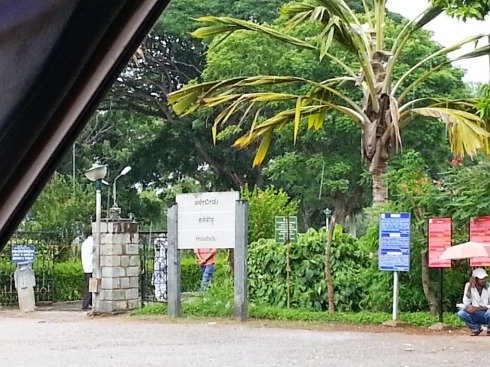
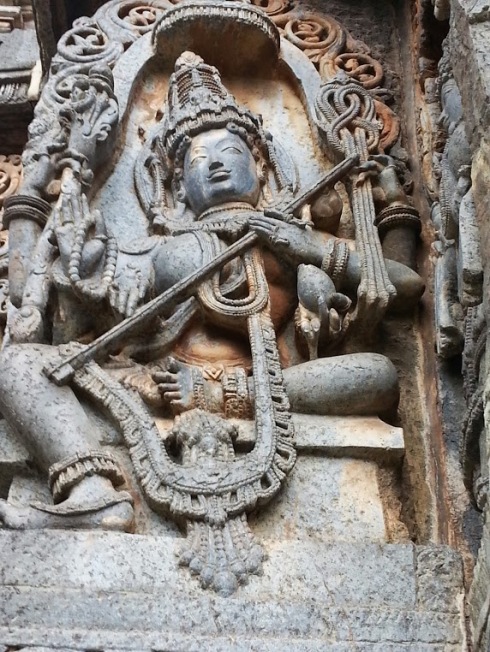
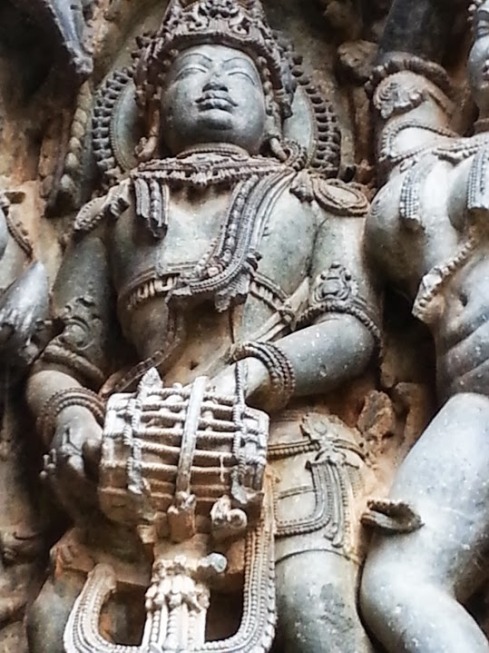
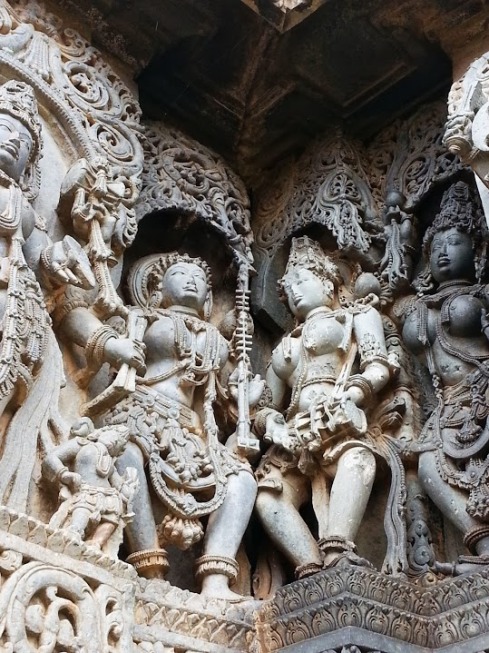
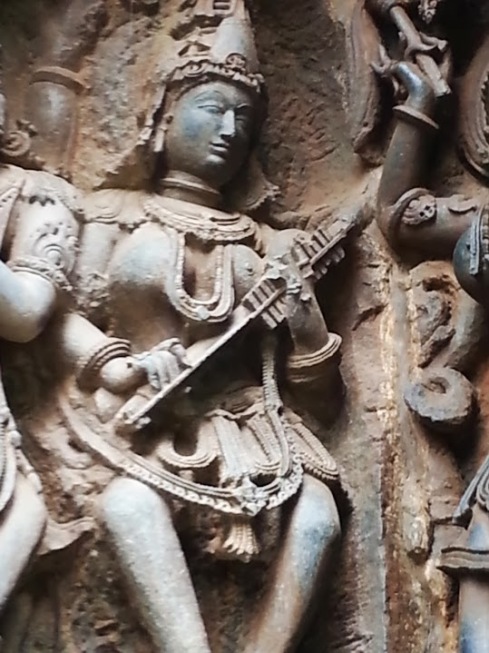
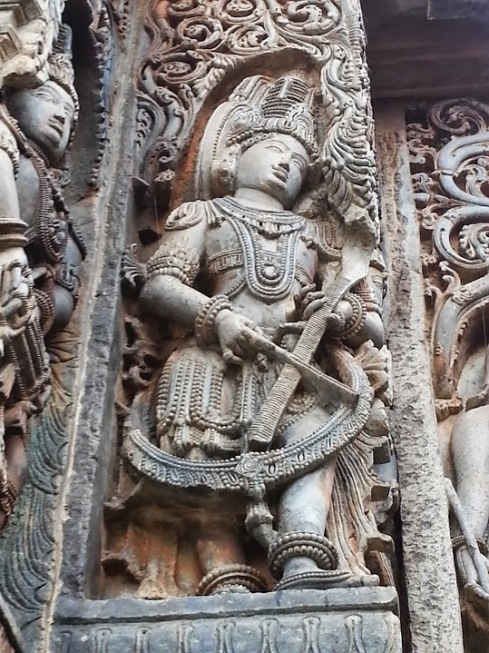
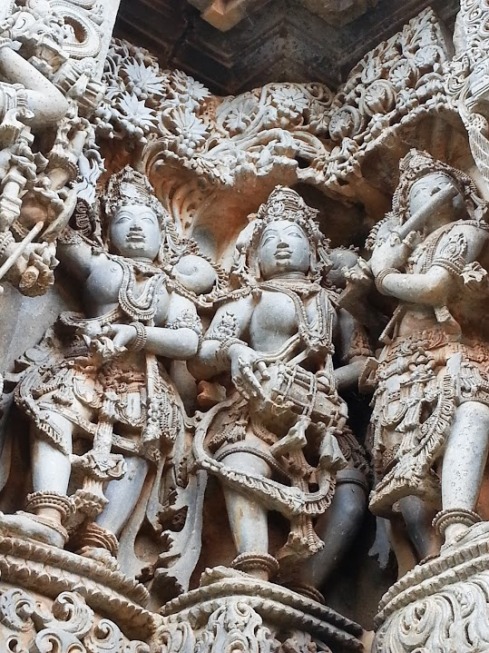


ಇತ್ತೀಚಿನ ಟಿಪ್ಪಣಿಗಳು